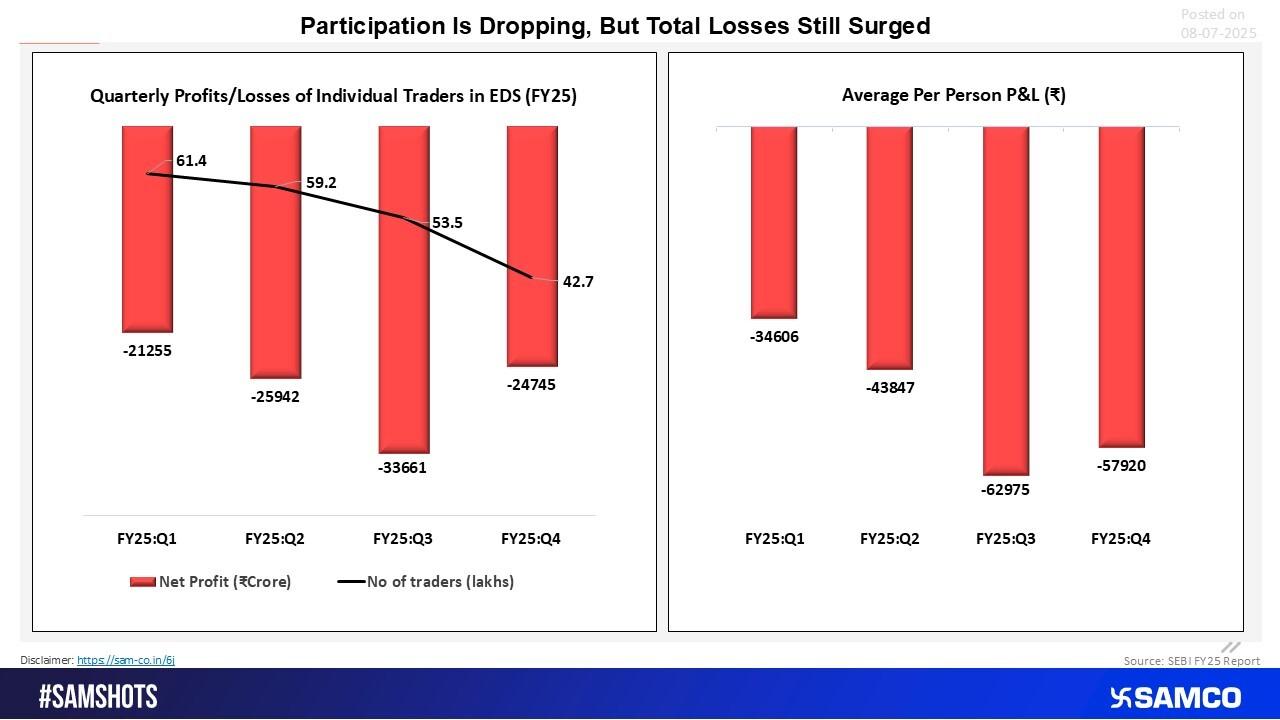Despite a sharp drop in retail participation in the futures and options (F&O) segment during FY25, the size of trading losses has only ballooned, painting a grim picture of India’s retail trading behavior. SEBI’s latest quarterly data shows that while fewer individuals are trading, the risk appetite of those who remain has grown alarmingly.
Retail Participation Drops 30%, But Losses Keep Rising
According to SEBI’s FY25 data:
- The number of active retail F&O traders fell from 61.4 lakh in Q1 to just 42.7 lakh in Q4, a 30% year-on-year decline.
- Yet, the net trading loss surged to ₹33,661 crore in Q3 alone—the highest for any quarter during the year.
- In Q4, total losses remained elevated at ₹24,745 crore, despite fewer traders.
This shows a paradox: Participation is falling, but financial damage is deepening.
Average Loss Per Trader Doubles in Just Two Quarters
What’s even more concerning is the per-person damage:
- Q1 FY25: Average loss per trader – ₹34,606
- Q3 FY25: Average loss per trader – ₹62,975
- Q4 FY25: Losses eased slightly to ₹57,920 per trader
Insight: This spike signals not just higher volatility but a rise in aggressive, high-leverage behavior among the remaining retail traders.
The Shift: Fewer, Riskier, More Addicted
Rather than walking away after repeated losses, many smaller retail traders doubled down—placing bigger, faster bets, likely chasing quick recovery or overnight success.
SEBI’s stricter regulations on F&O margin requirements and risk disclosures may have succeeded in reducing the number of casual traders. But they haven’t curbed the behavioral bias driving high-frequency, loss-chasing trades.
Why This Matters: A Dangerous Concentration
- The F&O market is becoming narrower and more speculative.
- A smaller group of retail traders is taking on disproportionate risk.
- The system is still flooded with leverage, and regulation alone may not fix the underlying behavioral flaws.
Key Takeaways
- 30% drop in individual retail Participation from Q1 to Q4 FY25
- Total trading losses peaked at ₹33,661 crore in Q3.
- Average per-trader losses nearly doubled in just six months.
- The market is now dominated by fewer but more aggressive participants.
- Regulatory tightening has slowed entry, not reduced risk behavior.
Final Thought: It's Not About Who Left — It’s About Who Stayed
The F&O ecosystem today is not necessarily safer—it’s more concentrated, more volatile, and deeply behavioral. The traders still active in FY25 may not be better informed—they might just be more willing to gamble.
Until education and risk awareness catch up with access and technology, the pain won’t be in exits—it will lie with those who keep playing, thinking they’ll win next time.





 Easy & quick
Easy & quick
Leave A Comment?